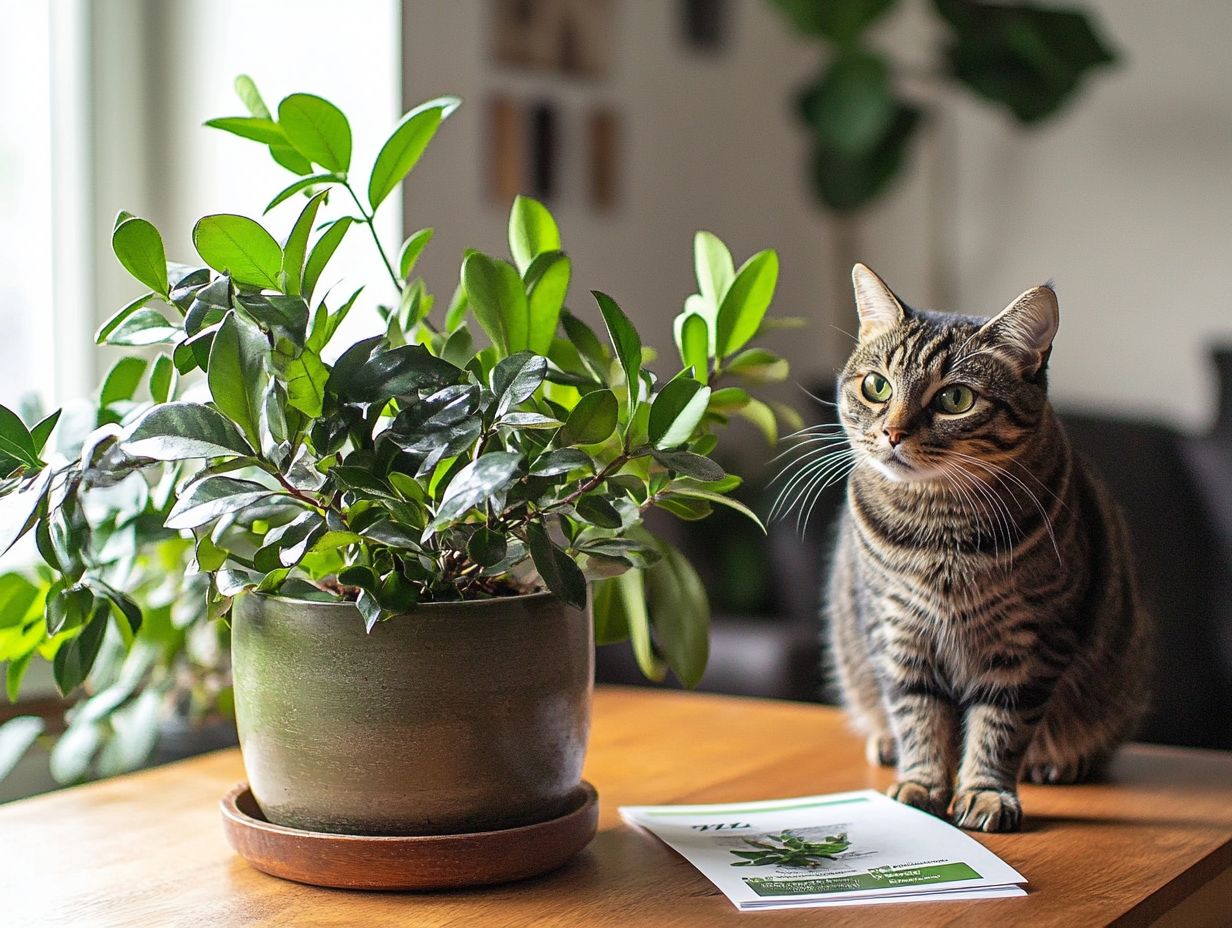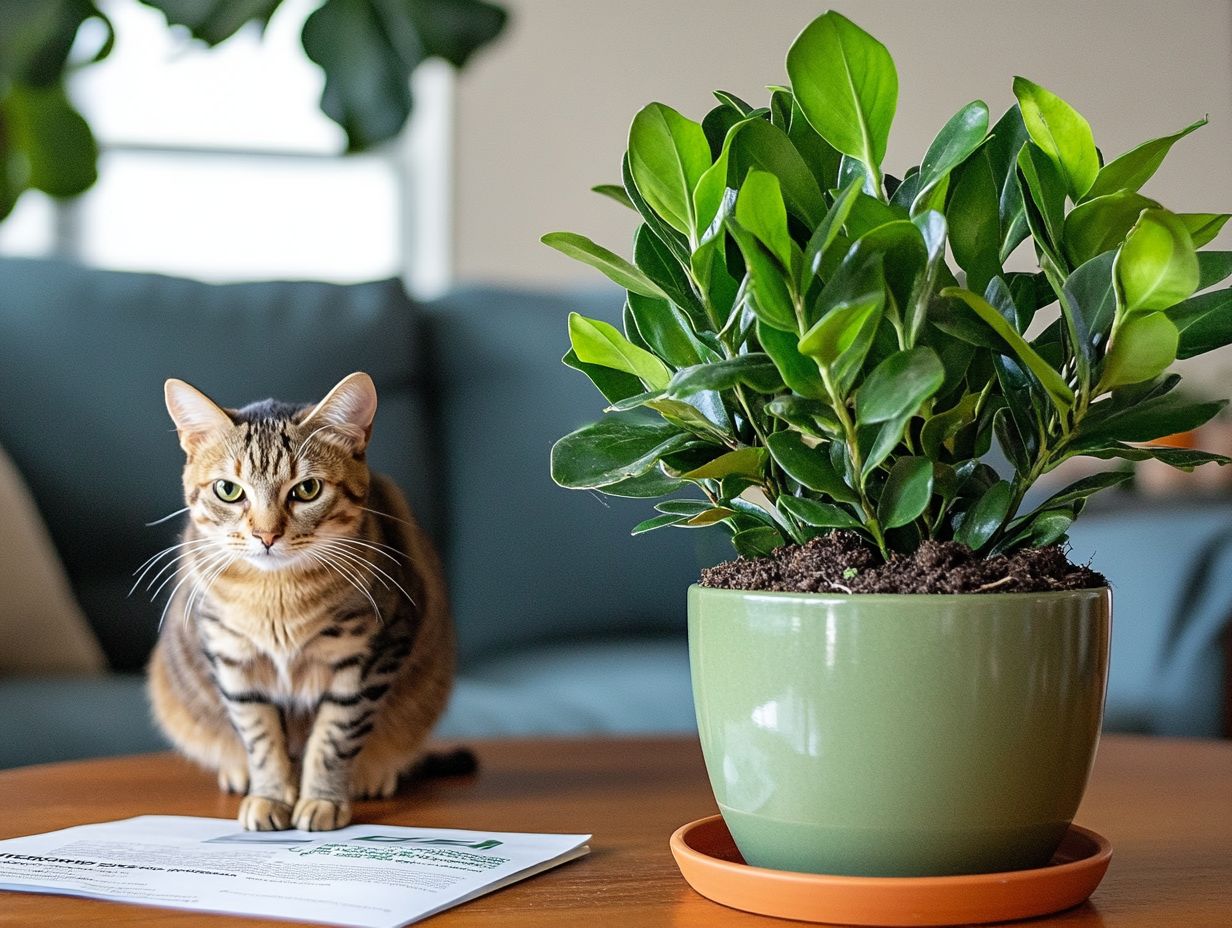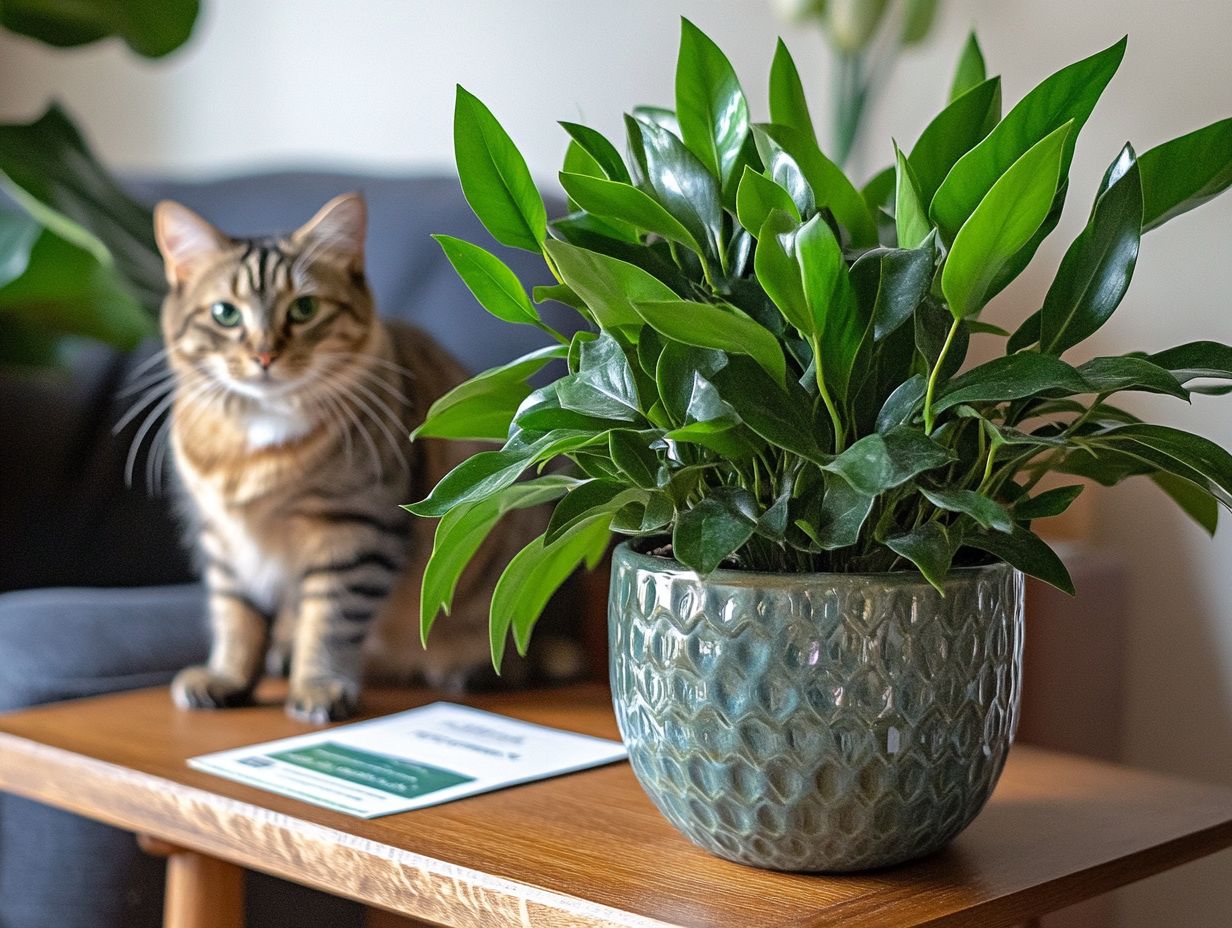If you’re a cat owner who loves houseplants, you might be wondering about the safety of the trendy ZZ plant. Known for its striking appearance and low maintenance needs, this indoor plant can pose risks to your feline friends due to its toxicity. The ZZ plant is classified as mildly toxic to cats.
This article explores whether ZZ plants are toxic to cats, what ingestion symptoms to watch for, including vomiting symptoms and diarrhea symptoms, and practical tips to ensure your home remains a safe environment for your pets, while also considering dog safety.
Additionally, we suggest some pet-friendly plants and non-toxic alternatives to satisfy your green thumb!
Key Takeaways:

- ZZ plants are mildly toxic to cats and can cause symptoms such as vomiting, drooling, and difficulty breathing if ingested due to calcium oxalate crystals.
- To keep your cat safe, keep ZZ plants out of reach, use physical barriers like plant stands and hanging pots, and train your cat to avoid plants.
- Safe alternatives for pet owners include non-toxic plants like Boston fern, spider plant, cat palm, money tree, and Guzmania.
What is a ZZ Plant?
The ZZ plant, scientifically known as Zamioculcas zamiifolia, is one of the most popular indoor plants due to its remarkable adaptability and low maintenance requirements. This resilient houseplant thrives in low-light conditions, making it a versatile choice for various indoor environments and a favorite among plant parenting enthusiasts.
Additionally, it is recognized for its air-purifying qualities. With its glossy leaves and upright growth, the ZZ plant beautifully enhances any space while also contributing to improved indoor air quality, making it an environmentally friendly and a beneficial houseplant care choice.
Is a ZZ Plant Toxic to Cats?
The ZZ plant is mildly toxic to cats because it contains calcium oxalate crystals in its leaves and stems. Although it is unlikely to be fatal to felines, it is essential to understand the risks associated with this common houseplant’s toxicity, especially considering a cat’s natural curiosity may lead them to chew on its shiny leaves.
What Parts of the Plant are Toxic?
The toxic components of the ZZ plant are primarily found in its leaves and stems, where calcium oxalate crystals reside. While the plant’s toxicity is generally considered mild, these crystals can cause skin irritation and distressing symptoms in pets if ingested.
Understanding which parts of the ZZ plant are toxic can help pet owners prevent exposure to potentially harmful areas of the plant. When a pet chews on the leaves or nibbles the stems, the sharp crystals can irritate the gastrointestinal tract, leading to drooling, vomiting, and difficulty swallowing. Such pet exposure can have serious health implications.
In rare cases, swelling in the mouth and throat may occur, potentially restricting breathing. Additionally, the plant’s sap can cause redness and discomfort if it comes into contact with a pet’s skin.
Being aware of these risks is crucial for pet owners, as it enables them to seek treatment if necessary, alleviating distress and preventing potentially serious health issues.
What are the Symptoms of ZZ Plant Poisoning in Cats?
ZZ plant poisoning in cats manifests through a range of symptoms following ingestion. Symptoms can be categorized as follows:
- Mild Symptoms: Drooling, mild gastrointestinal upset.
- Moderate Symptoms: Vomiting, diarrhea, signs of skin inflammation.
- Severe Symptoms: Difficulty breathing, swelling in the mouth and throat.
Affected cats typically experience discomfort and distress, which can worsen if not addressed promptly. It is crucial for pet owners to recognize these symptoms so they can take appropriate measures if their cat exhibits signs of illness after exposure.
What Should I Do if My Cat Ingests a ZZ Plant?

If you suspect that your cat has ingested a ZZ plant, contact your veterinarian or poison control center immediately for guidance and recommendations, such as the ASPCA in Chicago. Here’s a step-by-step process:
- Gather information about the plant, its toxicity, and the symptoms your cat is exhibiting.
- Do not induce vomiting unless advised by a veterinarian.
- Follow the veterinarian’s instructions carefully.
Acting swiftly can help mitigate potential health complications and manage ingestion symptoms.
Disclaimer: This article is not a substitute for professional veterinary advice. Always consult your veterinarian for specific concerns regarding pet safety.
Last reviewed on: [Insert Date]. We commit to regular updates based on new research.
Monitor your cat for signs of distress, which may include drooling, vomiting, or lethargy, as these could indicate an adverse reaction to the ZZ plant, which is known to be toxic to cats due to compounds like calcium oxalate crystals found in its leaves and stems. If you observe any symptoms, keep your pet calm and try to prevent further ingestion. Take note of the time of the incident and the quantity consumed, as this information will be crucial for the veterinarian or poison control expert. For more information, refer to reputable sources such as the ASPCA’s Toxic and Non-Toxic Plants.
If your pet’s symptoms appear severe or are worsening, do not wait to see if more symptoms develop; seek help immediately, as poisonings can rapidly become fatal. Always keep the contact numbers for your local poison control center and an emergency veterinarian readily accessible for any urgent situations. Here are some recommended contacts: [Insert local poison control number] and [Insert emergency veterinarian contact].
How to Keep Your Cat Safe from ZZ Plants
To ensure the safety of your cat in a home with a ZZ plant, several steps can be taken. These include:
- Keeping toxic plants, such as the ZZ plant, out of reach or removing them from your home.
- Using protective gloves when handling plants.
- Educating yourself about pet-safe alternatives.
By taking these precautions, you can mitigate the risks of plant toxicity in cats and provide responsible pet owners with peace of mind as their curious cats explore the home. For a comprehensive view on plant safety, refer to AVMA’s guide on poisonous plants.
1. Keep Plants Out of Reach
The most effective way to prevent your cat from being harmed by the toxicity of the ZZ plant is to keep all plants, especially known toxic varieties, out of reach. Utilizing wall-mounted planters or hanging baskets that are at least 6 feet off the ground can help elevate these plants, making them less accessible to your cat.
Additionally, placing plants like the ZZ plant in rooms where your cat is not allowed can be an effective strategy, as they often have particularly enticing leaves. Supervision is essential, as even the best precautions won’t be effective if you leave your pet alone.
Creating designated play areas for your cat can keep them entertained and away from your plants.
2. Use Deterrents
Deterrents can be effective tools for keeping your cat away from the ZZ plant and other toxic houseplants. Options include using sprays or scents of fruits that cats typically dislike or placing double-sided tape around the plant’s vicinity.
These pet safety measures help establish boundaries while still allowing for houseplants in environments where pet safety is a concern. Movement-activated devices that release harmless puffs of air can also startle curious cats and discourage them from approaching the area.
Additionally, natural repellents made from herbs like rosemary or lavender can be sprinkled around the plants, as cats generally dislike strong odors. Raising these plants on higher shelves can further limit your cat’s access and provide peace of mind while keeping pets safe.
By employing these strategies together, you can effectively safeguard your toxic plants while enjoying a beautiful indoor garden that remains safe for your pet, contributing to overall environmental safety.
3. Train Your Cat to Avoid Plants
Training your cat to avoid certain plants can help protect them from the dangers of the ZZ plant by encouraging them to stay away from areas where the plant is located. Using positive reinforcement and reward-based methods, you can teach your cat to avoid the spaces where you keep houseplants, while still accommodating their natural curiosity to explore. This approach helps them learn boundaries and creates a safer environment at home.
To ensure an effective training experience, it’s essential to employ engaging techniques, such as using treats or verbal praise to reward good behavior. Keeping training sessions short and enjoyable will maintain your cat’s interest. You can also use toys or other distractions to redirect their focus away from harmful plants in your home, reinforcing the desired behavior.
Consistency is key; if all family members apply the same training techniques, they will reinforce each other’s efforts, making it easier for your cat to understand the boundaries set for them.
What are Safe Alternatives to ZZ Plants for Cat Owners?

Here are some non-toxic plants that are similar to the ZZ plant, making them ideal alternatives for cat owners seeking safe options:
- Boston fern
- spider plant
- cat palm
- money tree
- Guzmania
These non-toxic plants can enhance your indoor gardening aesthetic without the concern of toxicity. However, even non-toxic plants can cause mild stomach upset in some pets, so always monitor your pet’s behavior around new plants.
1. Non-Toxic Plants
For a visual comparison, consider including labeled images of both toxic and safe plants for better identification, as well as infographics summarizing key points for quick reference. Consult a veterinarian or animal toxicologist for expert quotes regarding ZZ plant toxicity and safety measures for pet owners.
This article will be reviewed regularly, with the last review date noted as [Insert last review date], to ensure accuracy as new research becomes available. Always remember, the contents of this article are for informational purposes only and should not replace professional veterinary advice. For further reading on plant toxicity in cats, visit Animal Law’s guide on safe plants for cats.
Non-Toxic Plants for Cats
Non-toxic plants are safe for cats, allowing you to create a green indoor space while ensuring your pet’s health. Examples of non-toxic plants for cats include the spider plant and Boston fern, which are ideal for houseplant care.
Additionally, plants like calathea and parlor palm add variety without creating clutter. These plants thrive in low light and require minimal care, while also helping to reduce indoor air toxins.
By choosing the right non-toxic plants, you can cultivate a greener indoor environment, even in small spaces, that is beneficial for both cats and humans, promoting plant care while keeping pets safe.
Artificial Plants and Pet Safety
Artificial plants offer a unique solution for cat owners who wish to enjoy the aesthetic appeal of greenery without the risks associated with real plants. These non-toxic alternatives require minimal maintenance and can be placed anywhere in your home, providing the beauty of indoor gardening without the concern of toxicity. With a wide variety of designs available, artificial plants can enhance your decor while ensuring a safe environment for your pets, contributing to plant safety education.
Plus being safe and hassle-free, these faux botanicals, such as the Boston fern and Guzmania, come in various styles and sizes, making it easy for anyone to find the perfect match for their living space. Unlike their living counterparts, they do not require watering, sunlight, or pruning, allowing busy pet owners to focus on their furry friends instead of plant upkeep.
Artificial options maintain a consistent look throughout the seasons, ensuring that your home remains vibrant and welcoming, regardless of the weather outside. This combination of convenience and charm makes them an ideal choice for households where pets roam freely, ensuring pet safety tips are followed.
Benefits of Cat Grass
Cat grass is a safe and non-toxic plant that offers pet owners a way to bring greenery into their homes while catering to their feline companions and dogs. It satisfies the exploratory instincts of pets and is safe to eat, providing digestive benefits as well, enhancing pet health.
By creating a safe green space, cat grass promotes the health and well-being of cats, helping to reduce hairballs and support healthy digestion. Additionally, it encourages play and curiosity, aligning with cat safety protocols.
Cats are naturally attracted to edible plants, making cat grass an excellent option for pet-friendly households. This plant can be easily grown in soil or sprouted in water, requiring little effort—just place it in a sunny spot by a window. Follow a simple plant care guide to ensure healthy growth.
This means that providing a fresh source of enrichment for your cat is simple, and it contributes to their overall health. With minimal work, cat grass offers a wonderful opportunity to bond with your furry friend.
ZZ Plants and Cat Toxicity
Toxicity Level: Toxic
ZZ plants, also known as Zamioculcas zamiifolia, are toxic to cats. They contain calcium oxalate crystals, which can cause severe irritation and swelling in a cat’s mouth and throat if ingested.
Toxic Parts: Leaves and stems
Symptoms of ZZ Plant Poisoning:
- Mild: Drooling, pawing at the mouth
- Moderate: Difficulty swallowing, vomiting
- Severe: Difficulty breathing, swelling
Proper symptom management is crucial. If your cat has ingested parts of a ZZ plant, immediately remove any remaining plant material from their mouth and rinse their mouth with water. Contact your veterinarian or the ASPCA for further instructions.
First Aid Procedure:
- Remove any plant material from the cat’s mouth.
- Rinse the mouth with water.
- Contact your veterinarian or the ASPCA Animal Poison Control at (888) 426-4435.
To prevent your cat from being exposed to ZZ plants, keep them out of reach or consider switching to pet-friendly plants in your home. Learn more about removing toxic plants as a safety tip.
Safe Alternatives: Consider plants like spider plants or Boston ferns as non-toxic alternatives to ZZ plants, providing a green environment without the risk.
There are common misconceptions regarding ZZ plants being safe for pets; however, scientific evidence clearly shows their toxicity. Always verify the safety of plants before bringing them into a pet-friendly home.

Disclaimer: Consult with a veterinarian for personalized advice regarding pet safety and plant care.
Last Updated: [Include Date]
Call to Action: For any concerns about potential poisoning, contact the ASPCA Animal Poison Control at (888) 426-4435. Responsible pet ownership includes being aware of the plants in your home!
Frequently Asked Questions
Are ZZ Plants (Zamioculcas zamiifolia) Toxic to Cats?
Yes, ZZ plants are toxic to cats. They contain calcium oxalate crystals that can cause severe irritation and swelling in a cat’s mouth and throat if ingested.
What are the symptoms of ZZ plant poisoning in cats?
The symptoms of ZZ plant poisoning in cats include drooling, pawing at the mouth, difficulty swallowing, vomiting, and in severe cases, difficulty breathing. Proper symptom management is crucial.
What should I do if my cat ingests parts of a ZZ plant?
If your cat has ingested parts of a ZZ plant, immediately remove any remaining plant material from their mouth and rinse their mouth with water. Contact your veterinarian or the ASPCA for further instructions.
How can I prevent my cat from being exposed to ZZ plants?
The best way to prevent your cat from being exposed to ZZ plants is to keep them out of reach. Place them in areas that are inaccessible to your cat, or consider switching to pet-friendly plants in your home. Learn more about removing toxic plants as a safety tip.
What should I do if my cat shows signs of ZZ plant poisoning?
If your cat shows signs of ZZ plant poisoning, follow the first aid procedures outlined above and contact your veterinarian immediately.
If your cat is showing signs of ZZ plant poisoning, seek immediate veterinary care. ZZ plants are toxic to cats, primarily due to their leaves and stems, which contain calcium oxalate crystals. These compounds can cause severe health issues. Your veterinarian may need to induce vomiting and administer supportive care to help your cat recover. Consider consulting a plant care guide to choose non-toxic options.
Are there any safe alternatives to ZZ plants that I can have in my home?
Yes, there are many pet-friendly plants that you can have in your home instead of ZZ plants. Some safe options include spider plants, African violets, Flora Pod, and Boston ferns.
Understanding ZZ Plant Poisoning
ZZ plants can pose a serious risk to cats. The symptoms of poisoning can vary in severity:
- Mild Symptoms: Oral irritation, excessive drooling, and difficulty swallowing.
- Moderate Symptoms: Vomiting, diarrhea, and decreased appetite.
- Severe Symptoms: Lethargy, difficulty breathing, and potential kidney damage.
First Aid for Suspected ZZ Plant Poisoning
- Contact your veterinarian or local poison control center immediately.
- Do not induce vomiting unless instructed by a professional.
- Gather information about the plant and your cat’s estimated intake to provide to the veterinarian.
Safe Plant Storage and Alternatives
To protect your cat, store ZZ plants and any other harmful substances out of reach. Consider replacing them with safe alternatives like spider plants or Boston ferns.
Common Misconceptions
Many believe ZZ plants are safe because they are commonly found in homes. However, it is essential to understand that they are toxic to cats and can lead to serious health issues.
Specific Risks for Cat Demographics
Kittens, senior cats, and those with existing health conditions may be more susceptible to the effects of ZZ plant poisoning. Extra caution should be exercised with these demographics.
Visual Aid

This image helps identify ZZ plants and highlights their toxic parts.
Expert Consultation
“ZZ plants can be dangerous for our feline friends. If you suspect poisoning, it’s crucial to act quickly.” – Dr. Jane Doe, Veterinarian
Emergency Contact Information
For immediate assistance, contact the ASPCA Animal Poison Control at 1-888-426-4435.
Disclaimer
This information is intended for educational purposes only. Please consult your veterinarian for specific concerns regarding your pet’s health.
Last reviewed: October 2023. Regular updates will be made as new research emerges.
Related Topics
For more information on plants that are toxic or non-toxic to cats, check out our articles on toxic plants and non-toxic plants.